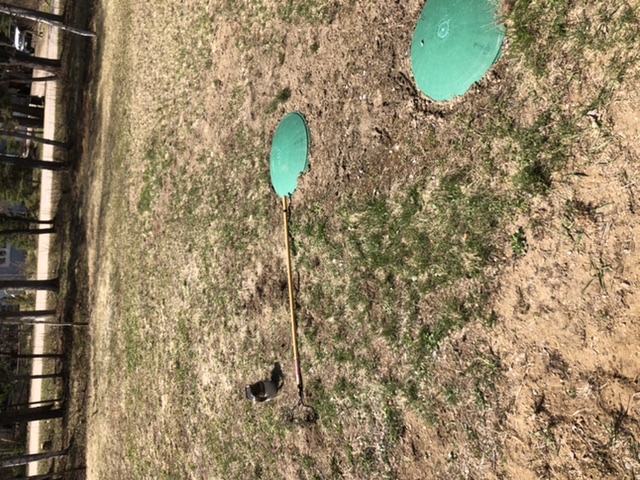
How far away (how close) can I plant a serviceberry tree in proximity to a septic tank and field?
(Photo: rake for perspective, jug where I’d like to plant the tree)
Here is an in-depth answer to a question similar to yours on our website. We have loads more information at www.torontomastergardeners.ca
https://www.torontomastergardeners.ca/askagardener/what-to-plant-near-septic-system-novice-needs-help/… . Generally speaking your septic system is a mini-wastewater treatment facility. It consists of the pipes that drain wastewater out of your home into an underground septic tank, which accumulates solid waste as it permits liquids to exit into the septic field. From the tank, a series of perforated distribution pipes set (usually) in gravel trenches slowly drain and evaporate the wastewater (this is the septic field or leaching bed). As the fluid effluent seeps into the ground, it is cleaned by the soil. These pipes need to be a certain depth below the surface in order to function properly, so it is important not to add much soil to the top of the drainage field. It is also critical to ensure that no plant roots damage the leaching bed. If you have swampy areas near the pipes, you may want to check with an expert to make sure the septic system is working properly. And if you have not done so already, I suggest that you get a copy of the plan that sets out the precise location/size of your septic system. You may have to ask your municipality or regional district for it. Mark out the area of your septic system so that you know its perimeter.
The best plants to grow have shallow roots – e.g., grasses and flowers. Do not rototill the top of the septic field when planting, do not dig deeply into the soil and avoid heavy mulching and watering the plants more than absolutely necessary – all of which could could interfere with the function of the field. Perennial flowers or ground covers and grasses are the best plants to select, as the less the septic field is disrupted by gardening the better. Lawn mixes can vary in what exactly is in them. You could begin to overseed with a mix that includes hard fescue, perennial ryegrass, clover, yarrow, violets. It makes a great alternative to standard lawn. This can be left to go ‘wild’ and it will feed pollinating insects. These mixes are some times referred to as ‘Envirolawns’.
Fruits and vegetables should be planted no closer than 3 metres (10 feet) from a septic system.
Many trees have woody roots that are more likely to block and harm the pipes, within a few years. Willow and poplar trees and other trees with aggressive water-seeking roots should be planted at least 15 metres (50 feet) away from the leach field. Cedars also are not recommended. As well, avoid the following trees and shrubs in the septic area: Aspen, Lombardy poplar, weeping willow, birch, beech, elm, most maple trees, American sweetgum, ash, tulip tree, Pussywillow, Japanese willow.
According to experts, it is not safe to plant any tree too close to a septic system. If you want to plant trees close to the septic area, do so as far as possible from the outside perimeter of the leaching bed. One rule of thumb for planting distance is to consider the height of the mature tree – for example, a tree that grows 25 feet (8 metres) tall at maturity should be planted at least 25′ from the edge of the bed. Your serviceberry grows to a hight of 25 feet. If you really want to plant trees or shrubs, make sure they are shallow-rooted. Some examples are:
Trees – Dogwood, Japanese maple, Eastern redbud, cherry trees (not the edible ones!)
Shrubs – Azalea, boxwood, holly
Caution :planting in the swampy area you mention, as trees/shrubs and other plants might experience root rot in areas where drainage is slow or the area remains wet.
Please see these sites for more information/reading:
SF Gate’s How to Plant a Garden in Relation to a Septic System Drain Field
The Spruce. Safe Plants to Grow Over Septic Tanks and Drain Fields
Township of Huron-Kinloss. Landscaping and your drainage field. This municipality provides suggested grasses and wildflowers that do well when planted over septic systems.
A number of governments and municipalities have terrific information on-line about septic systems. For example, see Nottawasaga Valley’s Septic smart – understanding your home’s septic system. This document includes suggested separation distances between leaching beds and gardens, trees, pools, etc.
Consider speaking with some of your neighbours, who likely had the same questions as you have when they moved in and may have figured out some plants that work well in the septic area. Your municipality may also have helpful resources and experts you can consult. Also, speak with someone at your local nursery about best plants for on/around septic systems – you won’t be the first to ask!
You are starting out wisely – by investigating what can/cannot be planted in and around the septic bed. For most other gardening, be happy that you have a huge area [outside the septic bed] in which you can plant vegetables, herbs, annuals, perennials and all the shrubs and trees you’d like! With any plants you are considering, remember to check soil, water and sunlight requirements. You may want to work with a contractor or designer to determine best options for your plot of land. Landscape Ontario has a great website that can help you locate experts in your area.
May you enjoy every aspect of gardening. All the best!

